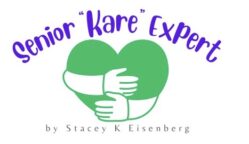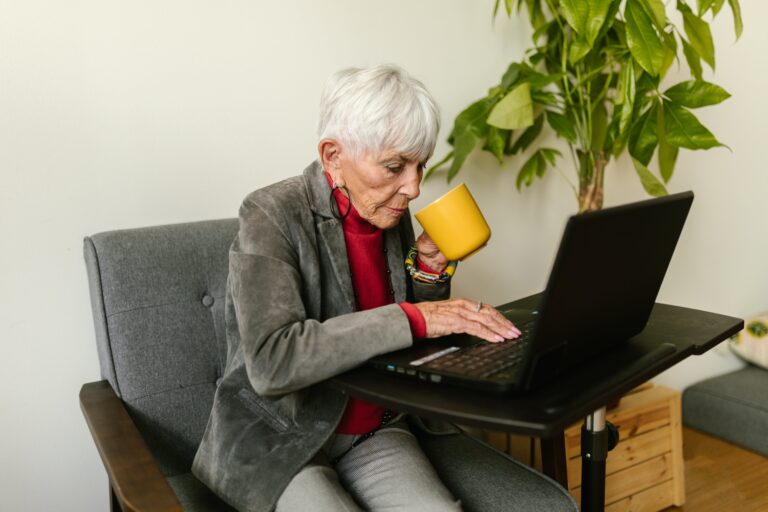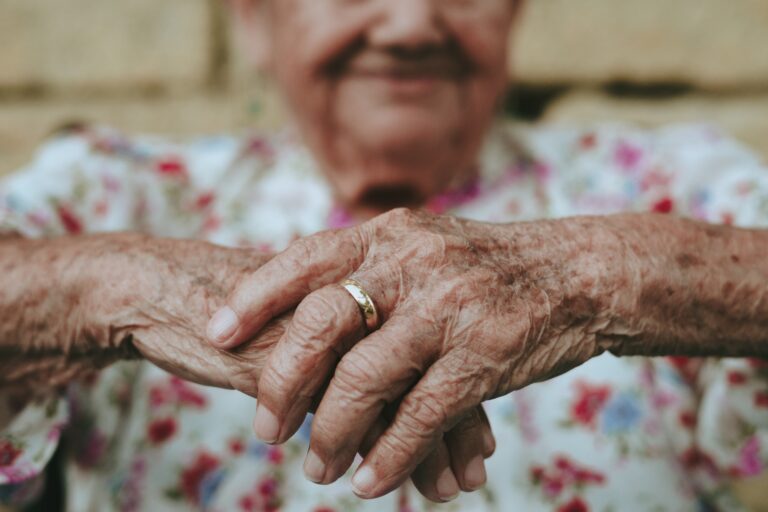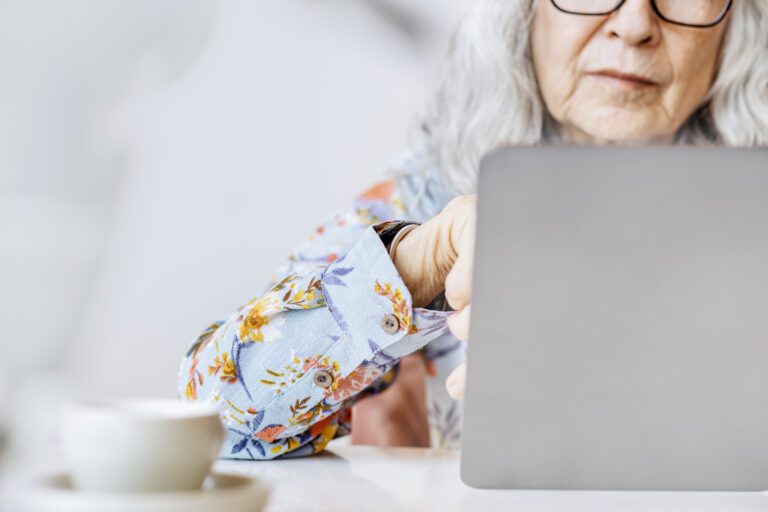Are you aware of the wide range of adaptive equipment for seniors and people with disabilities?
Adaptive items are products that are designed or modified to help people with different abilities perform daily tasks more easily and comfortably. They can range from clothing and footwear to cooking utensils and toileting equipment. Adaptive items can benefit seniors and people with disabilities who may have challenges with mobility, dexterity, vision, hearing, or cognition. There are a lot more options today than when I started caring for seniors almost four decades ago. If your senior has a challenge, there is probably a solution for them. Let’s look at some examples so that it can inspire you to find items that might help your seniors with their activities of daily living.
Adaptive Clothing and Footwear
Adaptive clothing and footwear are garments and shoes that have specific design features to make dressing and undressing easier and more comfortable. Some of these features include:
-
Velcro, magnetic, or snap closures instead of buttons, zippers, or laces
-
Open backs or sides that allow the wearer to slip into the clothes without lifting their arms or legs
-
Pull-on waists that eliminate the need for fasteners or belts
-
Stretchy or elastic fabrics that accommodate different body shapes and sizes
-
Extra room or adjustability for braces, casts, or prosthetics
-
Non-slip or skid-resistant soles that prevent falls and injuries
Adaptive clothing and footwear can help seniors and people with disabilities who have limited mobility, arthritis, Parkinson’s disease, stroke, dementia, or other conditions that affect their ability to dress themselves. They can also provide comfort, dignity, and style for the wearer.
Some examples of adaptive clothing and footwear are:
Magnetic Button Down Shirt: This shirt has hidden magnets behind the buttons, making it easy to put on and take off. It also has a chest pocket and a classic collar.
Open Back Dress: This dress has snaps at the shoulders and a generous back overlap, allowing the wearer to slide into it without raising their arms. Joe & Bella Freedom Chinos: These men’s and women’s pants have a stretchable waistband, side zippers, and magnetic closures to help with dressing. They even have pants designed for those with incontinence issues.
Silverts Women’s Easy Closure VELCRO® Brand Shoes: These shoes are self lacing or have velcro straps and a wide opening, making them easy to adjust and secure. They also have cushioned insoles and slip-resistant soles. You can also find Orthotic-ready shoes or pica clothing that accommodate people with foot deformities or sensory issues.
Adaptive Underwear: Designed for incontinence, with easy removal features.
Some of my most recommended Adaptive Clothing Websites
Buckandbuck.com – Clothing, Shoes, Footwear and Accessories – Men and Women
Silverts.com – Clothing, Shoes, Footwear and Accessories – Men and Women
Magnaready.com – Clothing for men and women with magnets
Slickchicksonline.com – Women’s Adaptive Intimates
Friendlyshoes.com – Zipper Closure – around back of shoe
Billyfootwear.com – Zipper Closure – whole top of shoe opens
Adaptive Cooking Utensils and Tables
Adaptive cooking utensils and tables are devices that help people with different abilities prepare and enjoy food. They can include:
– Knives, forks, spoons, and other cutlery that have ergonomic or weighted handles, angled or curved heads, or built-in guards to prevent slipping or dropping
– Cutting boards, peelers, graters, and other tools that have suction cups, clamps, or spikes to hold food in place or reduce the need for gripping
– Plates, bowls, cups, and mugs that have non-slip bases, high rims, or lids to prevent spills or messes
– Adaptive cups, glasses, and straws that have handles, lids, or spouts to make drinking easier and prevent spills¹
– Tables, trays, or stands that have adjustable heights, angles, or positions to suit different needs and preferences
Adaptive cooking utensils and tables can help seniors and people with disabilities who have tremors, weakness, pain, or loss of sensation in their hands or arms. They can also promote independence, safety, and enjoyment of food.
Some examples of adaptive cooking utensils and tables are:
Weighted Utensils: These utensils have large, soft, and non-slip handles that are easy to hold and control. They also have extra weight in the handles to reduce hand tremors.
One-Handed Cutting Board: This cutting board has stainless steel spikes that hold food in place and a corner guard that keeps bread from sliding. It also has rubber feet that prevent it from moving on the counter.
Scoop Plate: This plate has a high rim that helps push food onto the fork or spoon. It also has a non-skid base that keeps it stable on the table.
Adjustable Table: This table has a tilting top that can be set at different angles for reading, writing, or eating. It also has a height-adjustable base that can fit over a bed or a chair.
Spill-Proof Cups: To assist those with limited movement or tremors.
Adaptive Toileting Equipment
Adaptive toileting equipment are products that help people with different abilities use the bathroom. They can include:
– Raised toilet seats that increase the height of the toilet and reduce the distance to sit or stand
– Toilet safety frames or rails that provide support and stability for getting on and off the toilet
– Commodes or urinals that can be used in the bedroom or other places when the bathroom is not accessible or convenient
– Bidets or wipes that provide hygiene and comfort after using the toilet
Adaptive toileting equipment can help seniors and people with disabilities who have difficulty with balance, mobility, or continence. They can also enhance privacy, dignity, and quality of life.
Some examples of adaptive toileting equipment are:
Elevated Toilet Seat: This toilet seat adds 5 inches to the height of the toilet and has padded arms that offer support and comfort. It also has a locking mechanism that secures it to the toilet bowl.
Toilet Safety Rail: This rail attaches to the toilet and has adjustable handles that provide a firm grip and leverage. It also has rubber tips that prevent it from slipping or scratching the floor.
Folding Commode: This commode can be used as a standalone toilet or over an existing toilet. It has a foldable frame that makes it easy to store or transport. It also has a removable bucket, lid, and splash guard.
Portable Bidet: This bidet is a handheld device that sprays water to clean the genital or anal area. It has a rechargeable battery and a water tank that can be filled with warm or cold water. It also has a nozzle that can be adjusted for different spray modes and angles.
Adaptive Mobility Equipment
Mobility aids are vital for various reasons, especially for seniors, individuals with disabilities, or those recovering from injuries. Here’s an elaboration on the need for mobility aids:
-
Enhancing Independence: Mobility aids such as walkers, canes, and wheelchairs enable individuals who might otherwise be limited in their movement to move around independently. This autonomy is crucial for daily activities and maintaining a sense of self-reliance.
-
Injury Prevention: For those with balance issues, weakness, or conditions like arthritis, mobility aids can prevent falls and other injuries. They provide the necessary support to navigate safely, especially in environments that might pose a risk of slipping or tripping.
-
Recovery Support: After surgery or an injury, mobility aids can help in the rehabilitation process. They allow for gradual and safe movement, which is essential for proper healing without overexertion or strain on the injured area.
-
Reducing Pain and Discomfort: For individuals with chronic conditions like osteoarthritis or rheumatoid arthritis, walking and standing can be painful. Mobility aids help in reducing the load on painful joints, thereby alleviating discomfort during movement.
-
Improving Cardiovascular Health and Stamina: Regular use of mobility aids for movement can contribute to cardiovascular health. They enable users to engage in physical activity, which is essential for heart health and overall stamina.
-
Enhancing Social Participation: Mobility aids can help individuals to continue participating in social activities, attend events, and engage with their community, preventing social isolation and contributing to better mental health.
-
Adapting to Physical Changes: Aging often brings physical changes that can reduce mobility, such as muscle weakness, joint stiffness, and balance issues. Mobility aids help in adapting to these changes, allowing seniors to continue their daily routines more safely and comfortably.
-
Providing Psychological Benefits: The ability to move independently can have significant psychological benefits, including improved self-esteem, reduced feelings of dependency, and a better overall quality of life.
In summary, mobility aids are not just tools for movement; they play a multifaceted role in enhancing the quality of life, safety, and independence of individuals facing mobility challenges. They are instrumental in supporting a person’s physical health, social engagement, psychological well-being, and in maintaining an active, fulfilling lifestyle.
Some examples include:
Lift assistance: Assist in transitioning from sitting to standing.
Walkers and Rollators: For stable walking support. Check out the Roami 4 in 1 walker, rollator, stair assist and posture aligner.
Canes and Crutches: For balance and assistance in mobility.
Wheelchairs and Electric Scooters: For long-distance mobility.
Reacher Grabbers: To pick up items without bending over.
Button Hook and Zipper Pull: For easier dressing.
Communication Aids:
The need for communication aids among seniors is a critical aspect of their overall well-being and quality of life. Here’s an elaboration on why these aids are so important:
-
Compensating for Hearing Loss: Many seniors experience a decline in hearing ability. Communication aids like hearing aids, amplified telephones, and devices that provide visual alerts for sounds can significantly improve their ability to engage in conversations and remain aware of their environment.
-
Overcoming Speech Impairments: Conditions such as stroke, Parkinson’s disease, or other neurological disorders can affect a senior’s ability to speak clearly. Speech-generating devices or apps can assist them in expressing their needs, thoughts, and feelings more effectively.
-
Vision Impairment Adaptations: For seniors with vision impairments, large-button phones, voice-activated devices, and screen readers enable them to use technology for communication without the strain on their vision.
-
Cognitive Support: Seniors with cognitive impairments or memory issues, such as those associated with Alzheimer’s disease or dementia, can benefit from communication aids like picture phones or memory aids that help in remembering contacts and simplifying phone use.
-
Social Connection: Communication aids help seniors stay connected with family and friends, combating social isolation and loneliness, which are common issues in the elderly population. This connectivity is vital for mental and emotional health.
-
Emergency Assistance: Devices like personal emergency response systems (PERS) provide a way for seniors to call for help in an emergency. This is especially important for those living alone or with mobility issues.
-
Facilitating Telehealth: As telehealth becomes more prevalent, communication aids that enable seniors to effectively use telecommunication for healthcare can be crucial. This includes being able to participate in video calls or manage health apps.
-
Maintaining Independence: Effective communication aids can prolong a senior’s ability to live independently by making it easier to carry out daily tasks, ask for help, and stay engaged with their community.
-
Enhanced Quality of Life: Being able to communicate effectively contributes significantly to a senior’s overall quality of life. It allows them to share their experiences, engage in meaningful conversations, and maintain their personal relationships.
-
Adaptation to Technology Advancements: With the rapid advancement of technology, keeping seniors integrated and up-to-date with communication technologies can help them feel more included and less alienated in a digitally evolving world.
In summary, communication aids for seniors are not just about facilitating basic conversation; they are about ensuring that the elderly can maintain their social ties, independence, safety, and dignity in a world where communication is increasingly tech-driven. These aids play a vital role in bridging the gap created by age-related impairments and help in promoting a more inclusive and supportive environment for the elderly.
Examples of Communication Aids include:
Voice Amplifiers: For those with weakened voices.
Big Button Phones and Keyboards: For ease of use with vision or dexterity issues.
Picture Phones: For those with memory issues, enabling them to dial using images.
Fall Detection and Alert: For those who are at risk of falling.
CaptionCall: Accurate close captions on a large screen so you don’t miss any words.
This is far from a comprehensive list of assistive equipment. We hope that this article has given you some insight and inspiration on how adaptive items can improve your daily living. If you have any questions or feedback, please feel free to contact us.

From a young age, Stacey’s link to the senior care industry grew alongside her mother’s work at a nursing home, where she often accompanied her. By her early teens, she secured her first official job at a nursing home, laying the foundation for a profound journey in senior care spanning over four decades. Her roles varied from opening assisted living and memory care residences to working in nursing homes and independent senior living communities. As the former Director of Fun for 300 independent seniors, she expertly organized daily events and trips. Stacey’s unwavering passion, nurtured by her family, and professional dedication as a recreation therapist, reflect her deep commitment to preserving the dignity and well-being of seniors.
Stacey’s senior care expertise has been recognized by the media including U.S. News and World Report and Care.com.
Stacey and her husband Bryan are the owners of the senior in-home care agency A Place At Home – North Austin.




